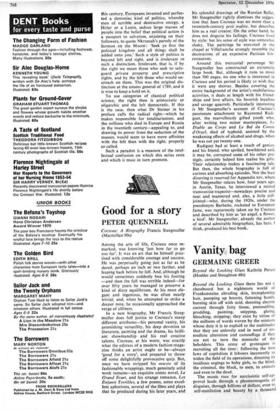Good for a story
PETER QUENNELL
Cocteau: A Biography Francis Steegmuller (Macmillan 90s) Among the arts of life, Cocteau once re- marked, was knowing 'just how far to go too far'. It was an art that he himself prac- tised with considerable courage and success. He was perpetually going just as far as he dared, perhaps an inch or two farther, and leaping back before he fell. And, although he would sometimes suddenly lose his footing —and then the fall was terrible indeed—for over fifty years he managed to preserve a kind of dizzy equilibrium. At his most ele- gant and ingenious, he was often nearly trivial; and, when he attempted to strike a deeper note, he occasionally approached the verge of silliness.
In a new biography, Mr Francis Steeg- muller does full justice to Cocteau's many different attributes—his personal vanity, his astonishing versatility, his deep devotion to literature, painting and the drama, his brilli- ant showmanship and his real creative talents. Cocteau, at his worst, was exactly what the editress of a modern fashion-maga- zine thinks an artist ought to be—always `good for a story', and prepared to throw off some delightfully provocative quip. But, once we have stripped his oeuvre of its fashionable wrappings, much genuinely solid work remains—an exquisite comic novel, Le Grand Ecart, and his strange romance, Les Enfants Terribles, a few poems, some excel- lent aphorisms, several of the films and plays that he produced during his later years, and his splendid drawings of the Russian Ballet. Mr Steegmuller rightly dismisses the sugges- tion that Jean Cocteau was no more than a twentieth-century petit maitre, but describes him as a real creator. On the other hand, he does not disguise his failings; Cocteau lived by style; but his sense of style was somewhat shaky. The paintings he executed in the chapel at Villefranche strongly resemble the decorations of an expensive Parisian fish- restaurant.
Around this mercurial personage Mr Steegmuller has constructed an extremely large book. But, although it runs to more than 500 pages, no one who is interested in Cocteau and his period is likely to wish that it were any shorter. Besides covering the entire background of the artist's multifarious activities, it deals at length with his friend- ships and love affairs, his feverish loyalties and savage quarrels. Particularly interesting is Mr Steegmuller's account of Cocteau's passionate attachment to Raymond Radi- guet, the marvellously gifted youth who, after writing two minor masterpieces, Le Diable au Corps and Le Bal du Comte d'Orgel, died of typhoid, assisted by the weakening effects of alcohol and drugs, when he was not yet twenty-one.
Radiguet had at least a touch of genius; and his friend, who spoiled, bewildered and. it may be, corrupted some of his other pro- tégés, certainly helped him realise his gifts. Their relationship makes a fascinating tale. But then, the whole biography is full of curious and absorbing episodes. Not the least diverting is reserved for Appendix xiv, where Mr Steegmuller relates how, four years ago. in Austin, Texas, he interviewed a retired transvestite-trapezist—nowadays precise and neat and mannered and, alas, a little stiff- jointed—who, during the 1920s, under the pseudonym Barbette, rocketed to European fame, was rapturously taken up by Cocteau and described by him as 'an angel, a flower, a bird'. Mr Steegmuller, already the author of several admirable biographies, has here, I think, produced his best book.










































 Previous page
Previous page